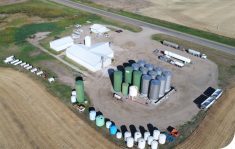Flooding isn’t the only thing almost no one is talking about this spring in the Red River Valley.
Winter wheat survival is also a subject of little chatter, and as with the flooding situation, silence is golden.
“We had a very good winter for winter wheat and in most cases I think we’ll see good survival,” said Manitoba Agriculture specialist John McGregor.
“This winter was fairly mild compared to the year before and the snow cover came on fairly early.”
Read Also

Volunteers help exotic animal farm rebuild
Exotic animal farm loses beloved camel and pony to huge hail storm that gripped the Brooks, Alta. area as a community member starts a fundraiser to help the family recover from the financial and emotional damage.
Last year, there was great concern and debate about whether much of the valley’s winter wheat had survived the brutally cold winter and subsequent Red River flooding.
Agrologists held clinics explaining winter wheat’s strengths and weaknesses.
McGregor urged farmers not to write off winter wheat crops before the soil temperatures had warmed enough to allow new growth to appear and not to assume they needed huge numbers of live plants per square metre to produce a good crop.
Flooding does not necessarily kill winter wheat plants as long as they are in dormancy when they are immersed. In the end, much of Manitoba’s crop managed to limp through the various challenges and survive.
This spring holds little fear of flooding. The late winter was warmer than average, not colder. Early snowfall covered the crops.
But farmers shouldn’t expect to see lots of new growth yet, McGregor said. On March 31, he said soil temperatures were too low to allow plants to begin sending out new shoots.
By April 7, continuing warmth should allow farmers to begin seeing new growth, he said. Once soil temperature warms to 2C-3C, the plants begin to become active again.
The greatest danger period for winter wheat survival is the late winter, from late February to April, when snow cover is disappearing but temperatures can still plunge into dangerous territory.
Last year, much snow cover was lost and cold temperatures arrived.
This year, the temperatures stayed above the danger zone and sufficient snow lingered.
“Right now, I’m very optimistic that the winter wheat, especially here in the southeast, should have survived quite easily,” said McGregor.

















